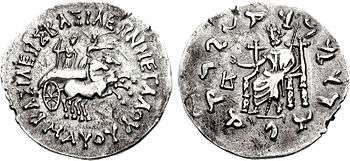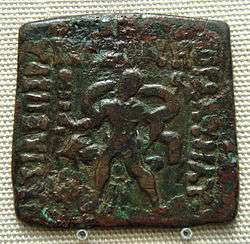Maues

Maues (Greek: Μαύης; epigraphically ΜΑΥΟΥ Mauou; r. 85–60 BCE) was an Indo-Scythian king who invaded the Indo-Greek territories.
Conqueror of Gandhara

Maues had his capital in Sirkap and minted most of his coins in Taxila. Maues did not manage however to conquer the Punjab territories of the Indo-Greeks east of the Jhelum, which remained under Greek control. After his death the Indo-Greeks regained most of their territory.
Maues is mainly known through his coins, which are often very closely inspired from Indo-Greek coinage. He represented Greek and Indian deities, and used Greek and Kharoshti in coin legends.
This tends to be indicative of a level of respect for Greek culture and a wish to assimilate it, rather than destroy it. Maues probably ruled his conquered territories based on his military might, but otherwise maintained cohabitation with local Greek and Indian communities. It has been suggested that Maues may have been a Scythian general hired by the Indo-Greeks, who would have briefly seized power, before the Indo-Greeks managed to take it back ("Crossroads of Asia").

Maues took the title of "Great King of Kings", an exceeded version of a traditional Persian royal title.
One inscription is known which mentions Maues (usually called the "Moga inscription", and starts with:
- "In the seventy eighth, 78, year the Great King, the Great Moga, on the fifth, 5, day of the month Panemos, on this first, of the Kshaharata and Kshatrapa of Chukhsa - Liaka Kusuluka by name - his son Patika - in the town of Takshasila..." [1]
Maues issued joint coins mentioned a queen Machene ("ΜΑΧΗΝΗ"). Machene may have been a daughter of one of the Indo-Greek houses.[2]
An Indo-Greek king, Artemidoros also issued coins where he describes himself as "Son of Maues".
Maues and Buddhism
A few of the coins of Maues, struck according to the Indian square standard, seemingly depict a King in a cross-legged seated position. This may represent Maues himself, or possibly one of his divinities. It has been suggested that this might also be one of the first representations of the Buddha on a coin, in an area where Buddhism was flourishing at the time.
Also, Maues struck some coins incorporating Buddhist symbolism, such as the lion, symbol of Buddhism since the time of the Mauryan king Ashoka.
The symbolism of the lion had also been adopted by the Buddhist Indo-Greek king Menander II. Maues therefore probably supported Buddhism, although whether sincerely or for political motives is unclear. His coins also included a variety of other religious symbol such as the cow of Shiva, indicating wide religious tolerance.
Other coins
 Maues seated with elephant holding victory wreath.
Maues seated with elephant holding victory wreath. Maues with Zeus putting hand on radiate figure.
Maues with Zeus putting hand on radiate figure. Maues with Zeus Nikephros handing victory wreath to elephant.
Maues with Zeus Nikephros handing victory wreath to elephant. Maues with elephant holding wreath of victory and bull.
Maues with elephant holding wreath of victory and bull.
Notes
- ↑ Moga inscription
- ↑ RC Senior "Indo-Scythian coins and history", Vol IV, p.xxxvi.
- ↑ O. Bopearachchi, "Monnaies gréco-bactriennes et indo-grecques, Catalogue raisonné", Bibliothèque Nationale, Paris, 1991, p.453
See also
- Meo
- Yuezhi
- Ahir clans
- Greco-Bactrian Kingdom
- Indo-Greek Kingdom
- Indo-Parthian Kingdom
- Kushan Empire
- Kambojas
- Kamuia
- Aiyasi Kamuia
- Kharaosta Kamuio
- Arta (Kamuia)
References
- "The Shape of Ancient Thought. Comparative studies in Greek and Indian Philosophies" by Thomas McEvilley (Allworth Press and the School of Visual Arts, 2002) ISBN 1-58115-203-5
- "The Greeks in Bactria and India", W.W. Tarn, Cambridge University Press.
- "The Crossroads of Asia. Transformation in image and symbol" ISBN 0-9518399-1-8
External links
| Preceded by: (In Arachosia, Gandhara and Punjab) Indo-Greek King Archebios (In Paropamisade) Indo-Greek King Hermaeus |
Indo-Scythian Ruler (85–60 BCE) |
Succeeded by: (In Gandhara) Indo-Greek king: Artemidoros (In Punjab) Indo-Greek king: Apollodotus II (In the south) Indo-Scythian ruler: Vonones |